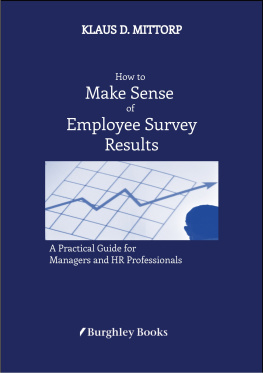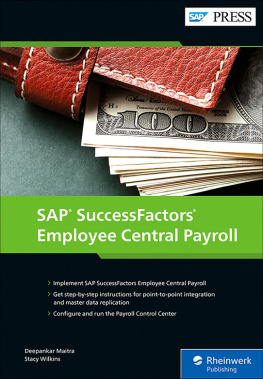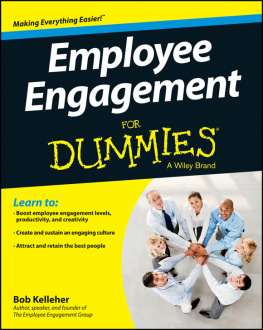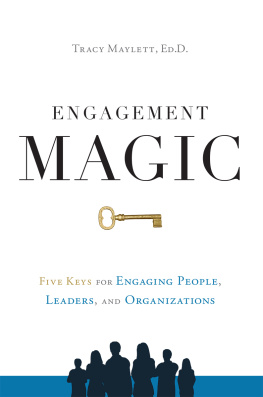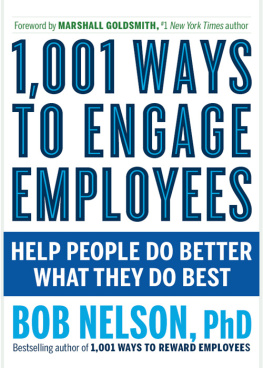EMPLOYEE
SURVEYS THAT
WORK
EMPLOYEE
SURVEYS THAT
WORK
IMPROVING DESIGN, USE,
AND ORGANIZATIONAL
_____IMPACT_____
ALEC LEVENSON


Employee Surveys That Work
Copyright 2014 by Alec Levenson
All rights reserved. No part of this publication may be reproduced, distributed, or transmitted in any form or by any means, including photocopying, recording, or other electronic or mechanical methods, without the prior written permission of the publisher, except in the case of brief quotations embodied in critical reviews and certain other noncommercial uses permitted by copyright law. For permission requests, write to the publisher, addressed Attention: Permissions Coordinator, at the address below.

| Berrett-Koehler Publishers, Inc.
235 Montgomery Street, Suite 650
San Francisco, California 94104-2916
Tel: (415) 288-0260, Fax: (415) 362-2512
www.bkconnection.com |
Ordering information for print editions
Quantity sales. Special discounts are available on quantity purchases by corporations, associations, and others. For details, contact the Special Sales Department at the Berrett-Koehler address above.
Individual sales. Berrett-Koehler publications are available through most bookstores. They can also be ordered directly from Berrett-Koehler: Tel: (800) 929-2929; Fax: (802) 864-7626; www.bkconnection.com
Orders for college textbook/course adoption use. Please contact Berrett-Koehler: Tel: (800) 929-2929; Fax: (802) 864-7626.
Orders by U.S. trade bookstores and wholesalers. Please contact Ingram Publisher Services, Tel: (800) 509-4887; Fax: (800) 838-1149; E-mail: customer.service@ingrampublisherservices.com; or visit www.ingrampublisherservices.com/Ordering for details about electronic ordering.
Berrett-Koehler and the BK logo are registered trademarks of Berrett-Koehler Publishers, Inc.
First Edition
Paperback print edition ISBN 978-1-62656-119-9
PDF e-book ISBN 978-1-62656-120-5
IDPF e-book ISBN 978-1-62656-121-2
2014-1
Full-service book production: Adept Content Solutions; Urbana, IL
Cover Design: Richard Adelson
To Tamara and Eve ~
for putting up with everything
CONTENTS
introduction
A ROADMAP TO EFFECTIVE EMPLOYEE SURVEYS
This is a book about improving the practice of designing, conducting, analyzing, and taking action from employee surveys.
Today it is easier than ever to conduct employee surveys, and they are widely accepted for gathering organizational intelligence. If anything, the pendulum may have swung too far: fatigue is often cited against fielding yet another survey. Surveys play a central role anytime large numbers of people are included in a sensing initiative. If the organization is changing, an employee survey can provide critical insights into change effectiveness. Surveys can be an effective tool for understanding the drivers of employee motivation and engagement. They can measure key organizational processes from the perspective of the employees most informed about themthose who implement the processes daily.
Despite the prevalence of employee surveys, a number of common survey practices are less than optimal. There are three general areas where survey practices can be improved: (a) strategy, goals, and objectives; (b) design and delivery; and (c) analysis, interpretation, and action taking from the results. This book addresses each of these areas and offers advice for improvement. Guidance is provided on whom to include in the survey, the issues to focus on, and balancing the tradeoffs involved.
The intended audience for the book includes both people who are responsible for designing and implementing employee surveys and those who use them, including HR leaders and practitioners, organizational development (OD) practitioners, and organizational leaders who oversee or use survey results. To keep the content accessible to as broad an audience as possible, a balance was struck between comprehensiveness and length and between more and less technical topics. This means that sometimes a topic is discussed in brief and, where appropriate, sources for additional information are provided.
Part one addresses common practices around employee survey goals, objectives, and methods that lead to suboptimal administrations. Surveys can be very long and cover too many topics. The target survey population often spans dissimilar business units, functions, roles, geographies, and groups of employees. Surveys often are promoted as measuring critical employee attitudes like engagement .
addresses survey purpose. Recognize the limitations of surveys. Dont overuse them or use only surveys when other types of assessments might be preferred or complementary, including interviews, focus groups, archival data analysis, direct observation, and so on. Start with defined outcomes that provide maximum support to top organizational priorities. Choose one or two top priorities and focus on them. Be clear about the organizational level best suited for addressing the survey priorities. Addressing multiple levels in the same survey is doable but harder than sticking to one level as the primary focus.
focuses on determining the right degree of emphasis on employee engagement. Contrary to common perception about the importance of employee engagement, monitoring and acting to improve employee attitudes is not advisable for most roles as a way to improve business performance. The benefits of improved employee attitudes accrue first and foremost to the employees. Whether the business subsequently benefits depends on the role and context. In certain customer-facing roles, there can be a causal link between employee engagement and business performance. In all other roles the link is tenuous at best and more likely is reversed: employee attitudes improve when business performance is high. Measures of employee engagement are best used as lagging or coincident indicators of business performance, not leading indicators.
. Choose survey questions most appropriate for the primary roles and processes that are the survey focus. The issues that most matter usually are not the same for people in different roles, functions, and geographies; when there are large dissimilarities, it is difficult to effectively address the highest priorities for everyone in a single survey. Even though you can include both individually focused and group-focused measurements, it is very hard to measure well both individual- and group-level issues in the same survey.
.
their energies on using the data to support organizational processes and drive change. Use multiple questions to increase the accuracy of measurement while minimizing overall survey length to encourage high response rates.
addresses the tradeoff between anonymity and insights. Matching survey responses with other data is needed to show a link to business performance. For employees like salespeople with clear performance metrics, the matching is best when it can happen at the individual employee level. Keeping the identity of survey respondents anonymous is the best way to ensure that they will feel comfortable answering all questions honestly. With anonymous survey responses, however, matching with other data can take place only at the group level. Ensuring anonymity or confidentiality is needed to encourage survey respondents to be honest about sensitive issues. Do not ask for extremely detailed demographic information that could be used to reverse engineer privacy controls and reveal peoples identities in a supposedly anonymous survey. There is a tradeoff between maximum data matching and complete anonymity: choose the right balance for the survey strategy.
Next page

